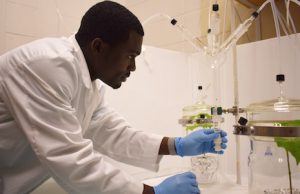
1. What experience or experiences led you to pursue a career in entomology?
There were a couple of experiences that got me interested in entomology, but I will share the most important one with you. It all started when I met Dr. Henry Fadamiro during one of his seminars as a visiting professor at my undergraduate university in Nigeria. I listened to his presentation. Dr. Fadamiro told us how phorid parasitic flies find their fire ant hosts, parasitize them, and decapitate them upon emergence. It was the first time I heard about parasitoids; I could not contain my fascination. The desire to know more about the life history and strategies of parasitoids drew me to the field of entomology.
2. Growing up in Nigeria, were you involved in agriculture? If so, what did you notice about agriculture? Were you interested in entomology at a young age?
I do not think I liked bugs at a young age, let alone having an interest in studying them at the time. Like many other kids, I experienced insect bites and stings, and that formed my opinion of insects in general. It was much later when I realized that we have the “good” insects, too – beneficial insects. I was involved in agriculture on a very small scale in Nigeria. My mother was a veterinary technician, and my father worked with a book publishing company, but my parents were also interested in agriculture. Growing up, my father took my siblings and me to his farm on the weekends. We grew corn, cassava, and oil palm. Corn and cassava are staple crops in Nigeria, but our family did not produce enough to make it a significant source of income at the time. It was more of a family activity for us. In Nigeria, a substantial amount of farm produce is lost to pest infestation in the field and in storage. Chemical control is the most common pest management tactic, but there are serious concerns about misuse and overuse, leading to widespread environmental issues and pesticide resistance. More recently, Nigeria faced a serious infestation problem with the tomato leaf miner Tuta absoluta. The infestation nearly crippled the supply of fresh tomatoes from the northern growing areas to the other parts of the country. The tomato leaf miner has not yet been reported in North America, but it is quickly spreading throughout the world. Biological control used as a component of integrated pest management is one of the best options to manage such invasive pests.
3. Your work is unique and focused on chemical ecology? How did you get involved in this kind of science please? Have you conducted chemical ecology work that has benefited crop producers?
Chemical ecology integrates chemistry and biology to understand the chemical communication among organisms in the ecosystem. This area of study can help us answer the following questions: how do pest insects select and locate their favorite host plants? How do plants respond to attack by insects? How do natural enemies find their prey/hosts? In addition, chemical ecologists also study the physiological and molecular bases of chemical interactions among organisms. As I previously stated, my desire to know more about the ecology of parasitoids drew me to entomology as an undergraduate student. I later joined Dr. Fadamiro’s program at Auburn University for my graduate study. I worked on two braconid parasitoids, Microplitis croceipes, and Cotesia marginiventris. I focused my research on understanding the chemical communication among plants, pest insects, and parasitoids. Most of my studies involved the identification of host-related volatiles (odorants) used by the two braconid parasitoids to locate the tobacco budworm Heliothis virescens on cotton plants. Naturally occurring chemicals that mediate intra- and interspecific communication are called semiochemicals. In addition to plant volatiles, my studies have identified key compounds emitted by cotton-fed tobacco budworm that mediates attraction of a braconid parasitoid species. These studies have potential practical applications in the formulation of attractants to recruit natural enemies of pest insects in the field. Studies from other research groups have demonstrated that compounds such as methyl jasmonate and the related cis-jasmone can prime indirect defensive response in crops. The principles of trap cropping, push-pull system, and mass trapping/mating disruption using pheromones, partly rely on semiochemicals. Chemical ecology is one of many tools that can be used to understand host selection and ecological interactions of invasive arthropods and biological control agents. That makes it a useful tool both in classical and conservation biological control.

4. What excites you the most about your work?
I am very excited to lead the invasive arthropod biological control program at UF/IFAS Indian River Research and Education Center, or IRREC. One of the advantages of working at a research center is that it creates a quick opportunity to collaborate across disciplines to solve practical problems affecting stakeholders. The state of Florida currently has several invasive insects and mites that cause serious agricultural losses and disrupts the ecosystem in natural areas. The Asian citrus psyllid is an example of an invasive insect that is causing severe agricultural losses because it transmits the citrus greening disease. Biological control is one of the best strategies for dealing with new invasive species. In classical biological control, natural enemies are imported from the native range of the invasive species; the agents are screened in quarantine before they can be cleared for release. The Morawo Biocontrol Lab will be located at IRREC’s Hayslip Biological Control Research and Containment Laboratory (BCRCL) in Ft. Pierce, FL. The BCRCL is a USDA-certified facility with both quarantine and non-quarantine laboratories for investigating natural enemy-prey/host interactions. I am excited about doing research in the containment laboratory. The BCRL currently has programs for the biological control of invasive weeds and arthropods. Research scientists at the University of Florida have been at the forefront of combating the problem of invasive species. Unfortunately, there will be new invasive arthropods that will find their way into Florida. With collaboration within and across the state, we are in a good position to respond effectively to the threats that current and future invasive species pose to our agricultural and natural areas.
5. What is your vision for your work with UF/IFAS?
To effectively manage invasive arthropods, it is important first to understand the invasion process and ecosystem effects of these species. A few of the questions I will be asking include: how are these species introduced? What are the patterns of spread? How do they impact the ecosystem? Classical biological control can be a lengthy process. I intend to develop more effective testing strategies for selected biological control agents so that we can increase the chances of success. These testing strategies will place more emphasis on multi-species chemical interactions that are critical to the effectiveness of the agent. For native and introduced biological control agents that already established, it is important to implement conservation techniques that will enhance their efficiency and integration into a broader integrated pest management strategy. The intersection of chemical ecology and conservation biological control presents a unique opportunity for applied research that quickly benefits growers.
My research will be on various crop systems and natural areas that are impacted by invasive arthropods in Florida. I plan to conduct research on the pests of citrus, tomato, soybean, and even honeybee hives, among others. My goal is to build a strong domestic and international research network that fosters collaboration and coordination on the management of invasive species. Besides research, I also have a teaching appointment in the department of Entomology and Nematology, where I will teach courses in Biological Control and Tropical Entomology. Teaching and student mentoring can be very rewarding. The same can be said of outreach efforts to share research products with the community. These activities will help me train the next generation of research scientists and agricultural practitioners that will go on to create knowledge and solve practical problems.
6. The citrus industry’s recovery is exceedingly important to growers in this region. Please — what is your vision for bringing the citrus industry back to Florida? Will you conduct work specific to the Asian citrus psyllid?
Citrus is Florida’s signature crop. The state produces the major share of citrus used for processing juice in the country, with total production only second to California. Accordingly, several UF/IFAS research scientists are working on various projects that benefit the citrus industry in Florida. UF/IFAS efforts span all aspects of citrus research. At IRREC, our scientists are working on multiple projects to support the historic Indian River citrus region and the citrus industry in the entire state. Among others, our research covers breeding, soil fertility, root health, water quality, invasive pest management, and post-harvest handling of citrus. The Asian citrus psyllid has become the key insect pest of citrus in Florida. Besides the direct feeding-related damage caused by this invasive insect, they also vector the pathogen that causes the Huanglongbing or citrus greening disease – the most devastating disease of citrus worldwide. An area of my research will focus on the biological control of the psyllid. Natural enemies such as predators, parasitoids, and even entomopathogenic fungi have been identified for the Asian citrus psyllid. I am interested in studying the community dynamics of the different natural enemy species associated with the psyllid in citrus. One of our research efforts will be to enhance the effectiveness of existing natural enemies, including the introduced ectoparasitoid Tamarixia radiata and various entomopathogenic fungi. Other pest insects of citrus to consider are the Lebbeck mealybug and Diaprepes root weevil. The recovery of the citrus industry from citrus greening or any other tree stressors will be a multidisciplinary collaborative effort. The good news is that those efforts are already on-going and yielding results.
 0
0
